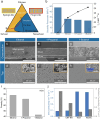Facile Lithium Densification Kinetics by Hyperporous/Hybrid Conductor for High-Energy-Density Lithium Metal Batteries
- PMID: 38647410
- PMCID: PMC11220661
- DOI: 10.1002/advs.202402156
Facile Lithium Densification Kinetics by Hyperporous/Hybrid Conductor for High-Energy-Density Lithium Metal Batteries
Abstract
Lithium metal anode (LMA) emerges as a promising candidate for lithium (Li)-based battery chemistries with high-energy-density. However, inhomogeneous charge distribution from the unbalanced ion/electron transport causes dendritic Li deposition, leading to "dead Li" and parasitic reactions, particularly at high Li utilization ratios (low negative/positive ratios in full cells). Herein, an innovative LMA structural model deploying a hyperporous/hybrid conductive architecture is proposed on single-walled carbon nanotube film (HCA/C), fabricated through a nonsolvent induced phase separation process. This design integrates ionic polymers with conductive carbon, offering a substantial improvement over traditional metal current collectors by reducing the weight of LMA and enabling high-energy-density batteries. The HCA/C promotes uniform lithium deposition even under rapid charging (up to 5 mA cm-2) owing to its efficient mixed ion/electron conduction pathways. Thus, the HCA/C demonstrates stable cycling for 200 cycles with a low negative/positive ratio of 1.0 when paired with a LiNi0.8Co0.1Mn0.1O2 cathode (areal capacity of 5.0 mAh cm-2). Furthermore, a stacked pouch-type full cell using HCA/C realizes a high energy density of 344 Wh kg-1 cell/951 Wh L-1 cell based on the total mass of the cell, exceeding previously reported pouch-type full cells. This work paves the way for LMA development in high-energy-density Li metal batteries.
Keywords: fast‐charging; lithium metal densification; lithium‐filling host; mixed conductor; nonsolvent‐induced phase separation.
© 2024 The Authors. Advanced Science published by Wiley‐VCH GmbH.
Conflict of interest statement
The authors declare no conflict of interest.
Figures






Similar articles
-
High dielectric single-ion conducting interphase enables fast-charging lithium metal batteries.J Colloid Interface Sci. 2025 Feb 15;680(Pt A):762-770. doi: 10.1016/j.jcis.2024.11.058. Epub 2024 Nov 10. J Colloid Interface Sci. 2025. PMID: 39536552
-
Commercially Viable Hybrid Li-Ion/Metal Batteries with High Energy Density Realized by Symbiotic Anode and Prelithiated Cathode.Nanomicro Lett. 2022 Jul 22;14(1):149. doi: 10.1007/s40820-022-00899-1. Nanomicro Lett. 2022. PMID: 35869171 Free PMC article.
-
Pre-Solid Electrolyte Interphase-Covered Li Metal Anode with Improved Electro-Chemo-Mechanical Reliability in High-Energy-Density Batteries.ACS Appl Mater Interfaces. 2021 Jul 28;13(29):34064-34073. doi: 10.1021/acsami.1c05966. Epub 2021 Jul 15. ACS Appl Mater Interfaces. 2021. PMID: 34264650
-
Design of Robust, Lithiophilic, and Flexible Inorganic-Polymer Protective Layer by Separator Engineering Enables Dendrite-Free Lithium Metal Batteries with LiNi0.8 Mn0.1 Co0.1 O2 Cathode.Small. 2021 Apr;17(13):e2007717. doi: 10.1002/smll.202007717. Epub 2021 Mar 10. Small. 2021. PMID: 33690967 Review.
-
Anode Material Options Toward 500 Wh kg-1 Lithium-Sulfur Batteries.Adv Sci (Weinh). 2022 Jan;9(2):e2103910. doi: 10.1002/advs.202103910. Epub 2021 Nov 16. Adv Sci (Weinh). 2022. PMID: 34784102 Free PMC article. Review.
References
-
- a) Lu J., Chen Z. H., Ma Z. F., Pan F., Curtiss L. A., Amine K., Nat. Nanotechnol. 2016, 11, 1031; - PubMed
- b) Choi J. W., Aurbach D., Nat. Rev. Mater. 2016, 1, 16013.
-
- a) Kuang Y. D., Chen C. J., Kirsch D., Hu L. B., Adv. Energy Mater. 2019, 9, 1901457;
- b) Chiu R. C., Garino T. J., Cima M. J., J. Am. Ceram. Soc. 1993, 76, 2257.
-
- a) Lin D. C., Liu Y. Y., Cui Y., Nat. Nanotechnol. 2017, 12, 194; - PubMed
- b) Ryu J., Han D. Y., Hong D., Park S., Energy Storage Mater. 2022, 45, 941;
- c) Liu J., Bao Z. N., Cui Y., Dufek E. J., Goodenough J. B., Khalifah P., Li Q. Y., Liaw B. Y., Liu P., Manthiram A., Meng Y. S., Subramanian V. R., Toney M. F., Viswanathan V. V., Whittingham M. S., Xiao J., Xu W., Yang J. H., Yang X. Q., Zhang J. G., Nat. Energy 2019, 4, 180.
Grants and funding
LinkOut - more resources
Full Text Sources
